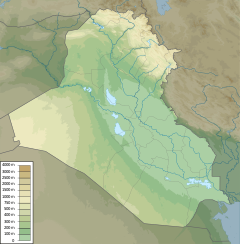Rassam cylinder
| Rassam cylinder | |
|---|---|
 Rassam cylinder of Ashurbanipal. A 10-sided prism and the most complete of the chronicles of Ashurbanipal. Nineveh, 643 BCE. British Museum.[1] | |
| Created | 643 BCE |
| Discovered | Nineveh 36°21′34″N 43°09′10″E / 36.359444°N 43.152778°ECoordinates: 36°21′34″N 43°09′10″E / 36.359444°N 43.152778°E |
| Present location | British Museum, London |
| Registration | BM 91026 |

an-szar2-du3-a man kur_ an-szar2{ki}
in the Rassam cylinder, 643 BCE.[2]

The Rassam cylinder is a cuneiform cylinder, forming a prism with ten faces, written by Neo-Assyrian king Ashurbanipal in the 7th century BCE, in 643 BCE. The cylinder was discovered in the North Palace of Nineveh by Hormuzd Rassam in 1854, hence its name. It is located in the British Museum.[4][5]
Content[]
The cylinder describes in detail nine military campaigns of Ashurpanipal.[4][5] The content of the cylinder has been listed as follows:
- Introduction, account of the accession of Ashurbanipal
- First Egyptian War against Tirhakah
- Second Egyptian War against Urdamane
- Conquest of Tyre and death of Ba'al, king of Tyre
- Expedition against , king of Van
- Expedition against Teumman, king of Elam
- War against Shamash-shum-ukin of Babylon, brother of Ashurbanipal
- First war with Ummanaldas, king of Elam
- Second war with Ummanaldas, king of Elam
- Expedition against Uate, king of Arabia
- Capture of Ummanaldas, king of Elam
- Embassy from , king of Ararat
- Repair of the Palace of Sennacherib at Nineveh, conclusion, and date of the inscription
— Content of the Rassam cylinder[6]
Extracts[]
One of these is his victorious campaign in Egypt:
In my first campaign I marched against Magan, Meluhha, Taharqa, king of Egypt and Ethiopia, whom Esarhaddon, king of Assyria, the father who begot me, had defeated, and whose land he brought under his sway. This same Taharqa forgot the might of Ashur, Ishtar and the other great gods, my lords, and put his trust upon his own power. He turned against the kings and regents whom my own father had appointed in Egypt. He entered and took residence in Memphis, the city which my own father had conquered and incorporated into Assyrian territory.
— Rassam cylinder of Assurbanipal (extract).[7]
Some reliefs from Nineveh are otherwise known that illustrate these campaigns.[8]
A full translation of the cylinder was made by Luckenbill in Ancient Records of Assyria and Babylonia.[4][5] A full transcription of the cuneiform is available on CDLI.[9]

Transcription of the cuneiform script of the first column.[10]

Translation of the first column by Luckenbill: Introduction and First Campaign of Egypt.[11]

Ashurbanipal "The First Egytian War". Word-for-word translation by George Smith.[12]
Important words[]

The word Mu-ṣur, for Egypt

The word Ku-u2-si, for "Kingdom of Kush"

The word Sha-ba-ku-u, for Kushite Pharaoh Shabaka

The word Tar-qu-u2, for Kushite Pharaoh Taharqa

Tar-qu-u, an alternative spelling used for Kushite Pharaoh Taharqa

The word Urdamanee, for Kushite Pharaoh Tantamani

The word An-shar-pap-ash, for Neo-Assyrian ruler Esarhaddon

The word An-shar-du-a, for Neo-Assyrian ruler Ashurbanipal

The word Aššur KI, for the city of Assur

The word mat Aššur KI, for the country of Aššur, Assyria

The word An-shar, for supreme god Anshar

The country of Meluhha (





